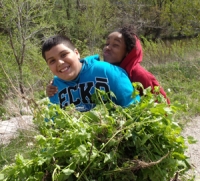I took on the mentality that I needed to convince kids to like these things, it was necessary in order to “foster ecological understanding and inspiration for change.”
To my surprise, this approach didn’t always work. I noticed how I was projecting my experiences onto the students, instead of understanding that each of us have our own relationship with nature, and our connection to it is going to play out differently. Telling my students how to experience nature wasn’t honoring the diversity of perspectives we each brought to environmentalism, but rather it was making nature seem exclusive in how it could be enjoyed.
Understanding and inspiration can’t be forced. The same dilemma occurred in my role as volunteer coordinator and community health evaluation coordinator. In trying to understand what motivated people to volunteer and how outdoor play improved health, I came to the conclusion that the voices within the community I was working with were necessary contributions to this working definition of environment.
I continue to question how to make environmentalism more inclusive, striving to understand how it looks in others’ lives, beyond the confines of flannel and hiking boots, allowing it to be more dynamic and comprehensive. I can’t say that I’ve landed on a clear cut answer, but working at the Center has given me the chance to really explore how we can all contribute to redefining environmentalism through the way we cook, dance, play outside and how valuing each person’s contribution is essential.
My time here has helped me see that my own experiences and motivations don’t apply to all, and that the work toward inclusivity requires asking the question: What does environmentalism mean to you?





